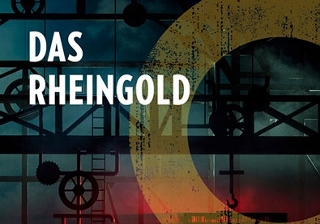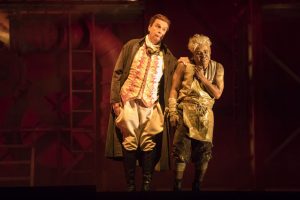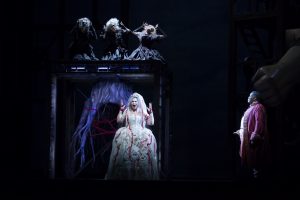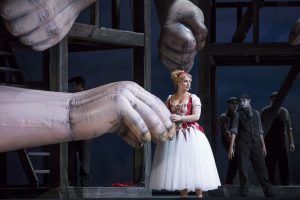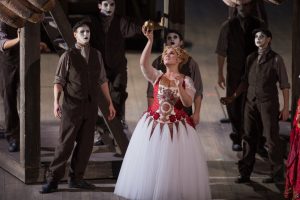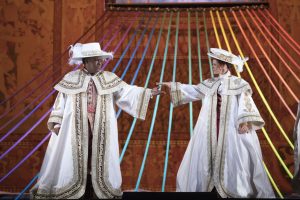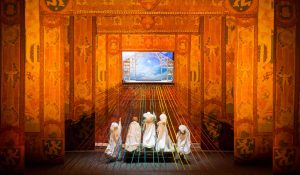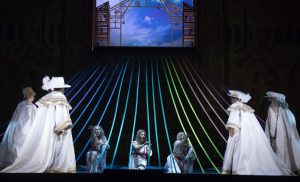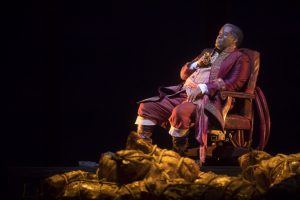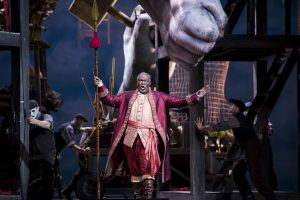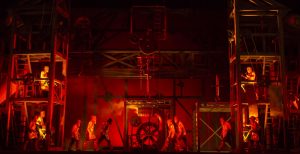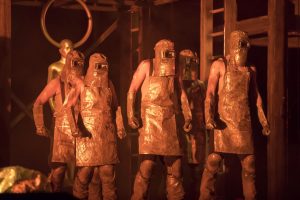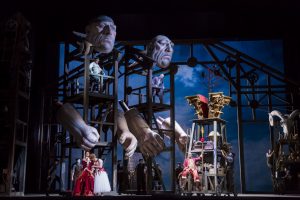LYRIC BRINGS HOME THE GOLD
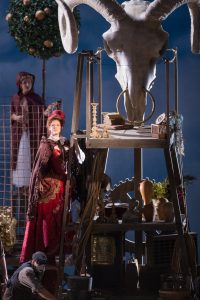 Wagner’s Ring Cycle has arrived in Chicago and it is magnificent. If you’re like me and you’ve never seen it before, then prepare yourself for an experience beyond imagining. Richard Wagner’s epic fantasy features a cast of gods, giants, dwarves, and nymphs, a plot contrasting love and beauty with power and wealth, and some of the most evocative music ever written. Lyric Opera brings the full gamut of its immense resources to bear on this season-opening production, including the expanded orchestra conducted by Sir Andrew Davis, a cast of internationally renowned singers, and new stage equipment that significantly improves the company’s ability to create stunning visual effects. Story, music, drama, and scenery all fit together in a complex and harmonious whole, just as Wagner intended. And the two-and-a-half hour Das Rheingold is just the opening salvo of his four-opera cycle Der Ring des Nibelungen. Lyric aims to present the remaining parts in successive installments over the next four years, culminating with the entire cycle in 2020. It’s an ambitious and exciting plan.
Wagner’s Ring Cycle has arrived in Chicago and it is magnificent. If you’re like me and you’ve never seen it before, then prepare yourself for an experience beyond imagining. Richard Wagner’s epic fantasy features a cast of gods, giants, dwarves, and nymphs, a plot contrasting love and beauty with power and wealth, and some of the most evocative music ever written. Lyric Opera brings the full gamut of its immense resources to bear on this season-opening production, including the expanded orchestra conducted by Sir Andrew Davis, a cast of internationally renowned singers, and new stage equipment that significantly improves the company’s ability to create stunning visual effects. Story, music, drama, and scenery all fit together in a complex and harmonious whole, just as Wagner intended. And the two-and-a-half hour Das Rheingold is just the opening salvo of his four-opera cycle Der Ring des Nibelungen. Lyric aims to present the remaining parts in successive installments over the next four years, culminating with the entire cycle in 2020. It’s an ambitious and exciting plan.
The narrative arc of Das Rheingold is beautifully constructed, beginning and ending with the Rhinemaidens who guard the titular gold. As these river nymphs tempt the lecherous Nibelung (or dwarf) Alberich with their enchanting beauty, they tell him of the gold’s power, which can only be unlocked by the one who renounces all love. To their surprise, the dwarf does so and takes the gold, crafting the ring that gives its name to the cycle. The drama then ascends to the heavenly realm of the gods as they view for the first time the palace built for Wotan by the giants Fasolt and Fafner.
As payment, the giants demand the goddess Freia, sister to Wotan’s wife Fricka. Loge, Wotan’s cunning half-divine advisor, persuades the giants to accept the dwarf’s gold in lieu of Freia. Wotan and Loge descend to the nether regions where Alberich lives and abduct him along with his gold. They return to the heavens and trade the gold for Freia, but not before Wotan is persuaded by the earth goddess Erda to give up the ring too. As soon as he hands it over, the giants fight for it, Fasolt killing Fafner. Finally, crossing via a rainbow bridge built by Froh in the aftermath of Donner’s storm, the gods enter Valhalla.
Apart from current and former Ryan Opera Center members, nearly all of those in the cast are making American and/or Lyric debuts. Masterfully playing the role of Loge, Slovakian tenor Å tefan Margita is a notable exception. His voice is beautifully clear and light in a way that one does not often associate with Wagnerian opera. An illustrative contrast is provided by Eric Owens’ thick and plodding bass-baritone (heard to better effect last year in Porgy and Bess). Owens’ Wotan, though large and regal, seems much too old and sedentary to be the powerful king of the gods.
Samuel Youn’s Alberich, though physically diminutive, has the vigor and energy to be a worthy opponent. Youn combines expressive and emphatic phrasing with formidable acting skills, including a flare for the self-deprecatingly comedic, in this production’s finest performance. Diana Newman, Annie Rosen, and Lindsay Ammann, the Rheinmaidens who taunt Alberich, spice up this dramatic tale with a welcome measure of siren-like sex appeal.
As an opera combining such a diverse scenery and characters along with numerous visual effects, Das Rheingold can be challenging to stage. Director David Pountney, however, manages it superbly, envisioning the whole in steampunk style. This comes out most strongly in the set and costume designs for the dwarvish underworld in Scene Three, and to a lesser extent throughout. Scenery designer Robert Innes Hopkins makes use of an original design of Johan Engels (1952-2014) comprising a large superstructure that breaks apart to form the bodies of the giants Fasolt and Fafner. Its innumerable moving parts also help create the effect of the Rhinemaidens’ riverine home as well as the gods heavenly one. Marie-Jeanne Lecca’s imaginative costumes and Sarah Hatten’s wigs and makeup combine the gothic with the carnivalesque to create a truly fantastic aesthetic.
The one thing conspicuously lacking in this production (besides an intermission) is Lyric Opera’s awesome chorus. Otherwise it has everything you could want in an opera and more! Stayed tuned for the rest of the Ring Cycle, but until next year audiences can enjoy one of the most exciting seasons yet. Still to come are three French operas, two Italian operas, a Russian one, and another German, this time by the ever-popular Mozart. From Berlioz’s epic of the Trojan War to Bellini’s bel canto masterpiece, it promises to be an extraordinary blend of seldom-performed works and beloved favorites.
photos by Todd Rosenberg and Andrew Cioffi
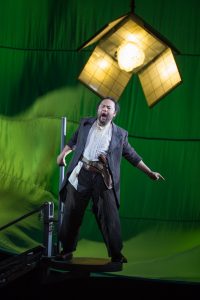 Das Rheingold
Das Rheingold
Lyric Opera of Chicago
Civic Opera House, 20 N. Wacker Drive
ends on October 22, 2016
for tickets, call 312.827.5600 or visit Lyric Opera
for more shows, visit Theatre in Chicago
